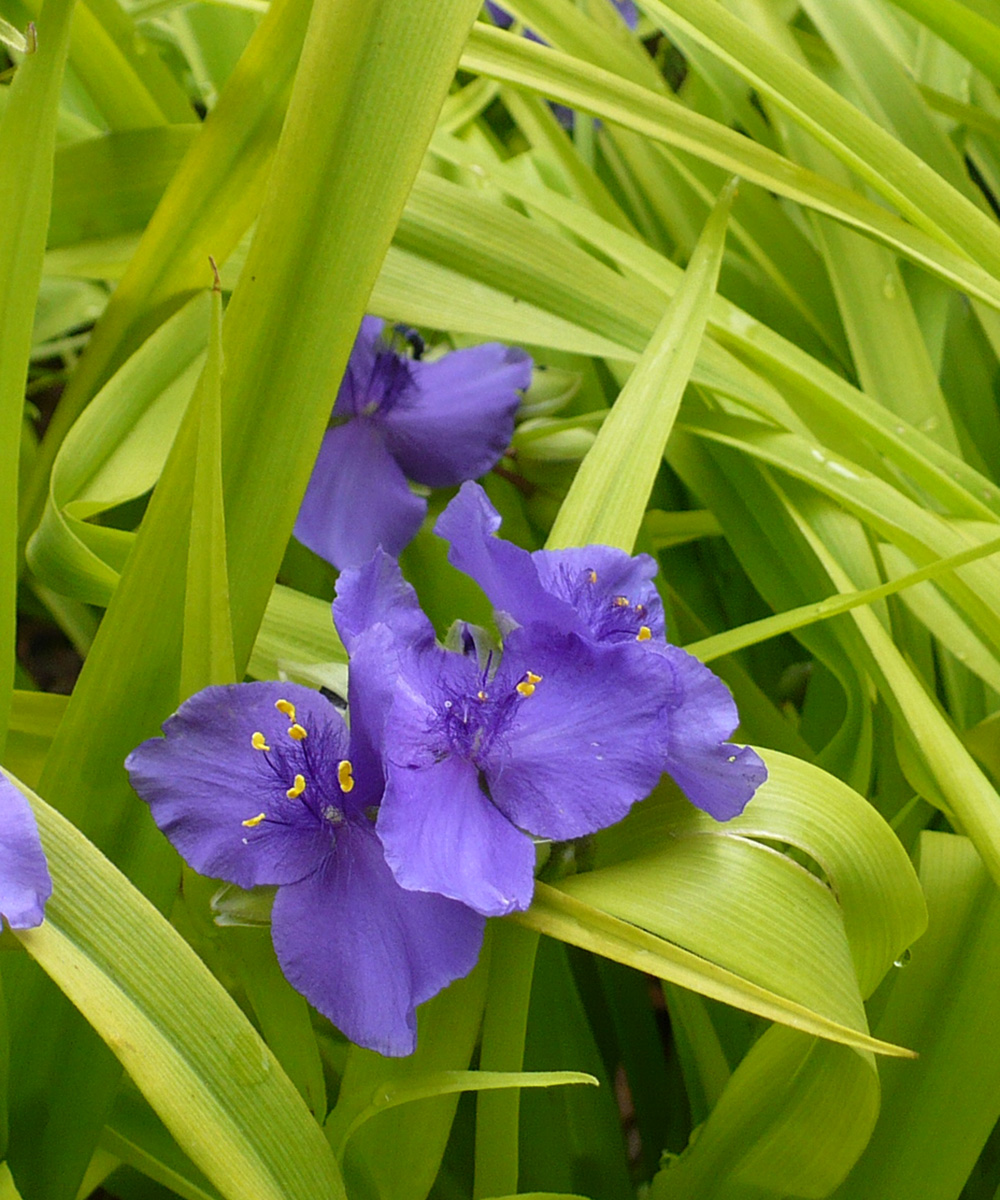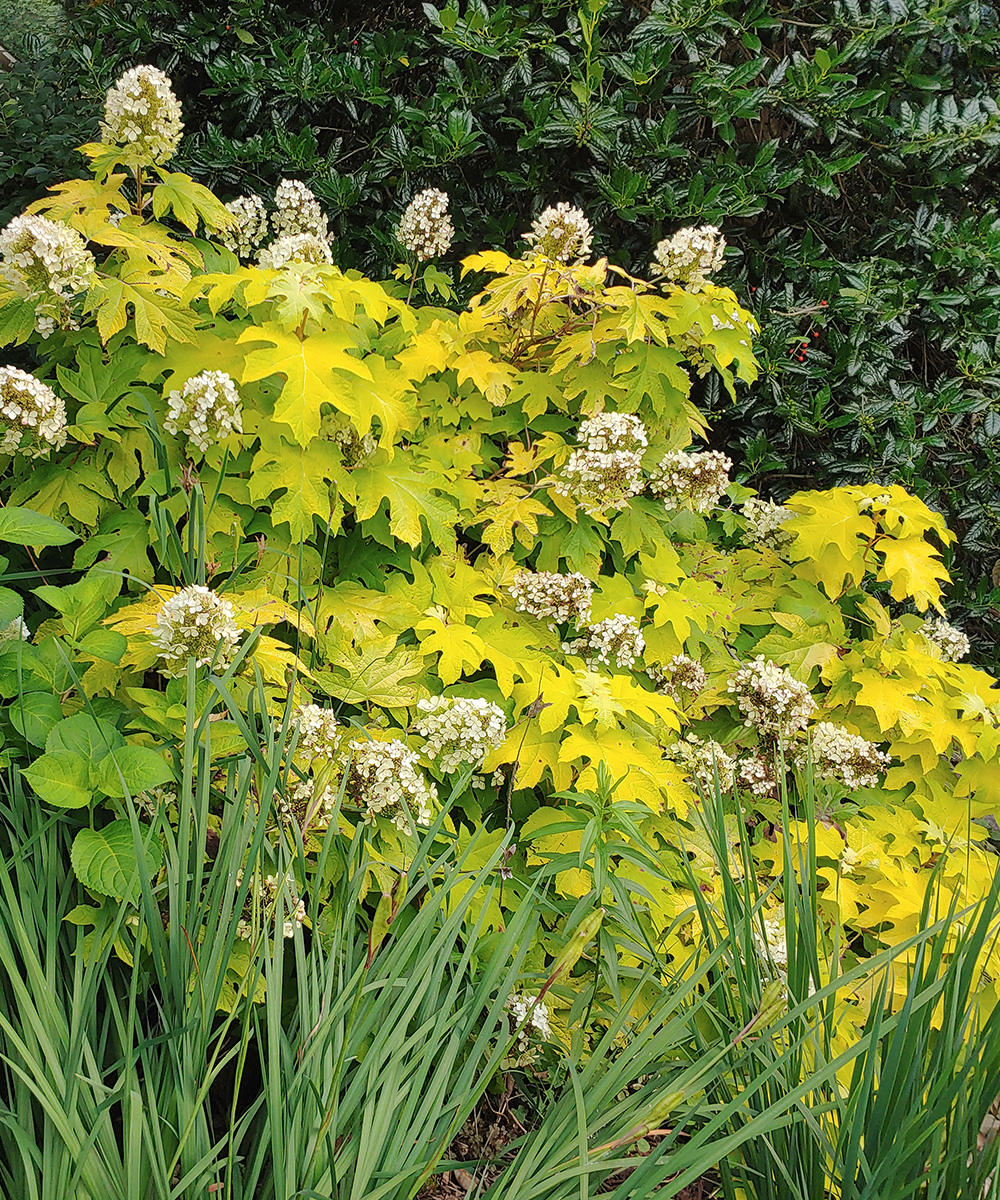
Chartreuse foliage—do you love it, or do you have the impulse to throw fertilizer at it? Either way, it makes you look, doesn’t it? That yellow-green shade owes its classy name to a French liqueur, but it might just as accurately (if not as elegantly) be described as the color of lemon-lime Gatorade.

Chartreuse foliage highlights bold colors better the lighter it is
Chartreuse leaves have visual magnetism, leaping forward out of seas of shady greens and serving to emphasize primary colors like reds, pinks, and blues by contrast. As a general rule, the more yellow the shade leans, the more of a punctuating focal point it provides. Chartreuse that is on the greener end of the spectrum blends more easily and can be used liberally. Perhaps because of the design potential of this color, chartreuse plants are hot right now. Breeders are paying attention to the demand, and new cultivars of annuals, tropicals, perennials, shrubs, and even trees have been appearing in nurseries over the last decade or so.

Plants bred to have chartreuse foliage aren’t sick!
If you feel the urge to “feed that poor plant,” I get it. I may be a fangirl of chartreuse now, but I once shared your view. Chartreuse takes the fresh light green of new spring growth and turns up the yellow knob. While the yellow-green of spring is spirit-lifting and perhaps hard-wired to attract our attention, that same color covering a typically dark green plant in summer raises a red (er, yellow) flag—the flag of chlorosis. Chlorotic plants are experiencing a reduction in chlorophyll (the all-important light-gathering pigment that jump-starts photosynthesis), which signals a deficiency in nitrogen, iron, magnesium, or all of the above. These deficiencies may be evidence of any number of conditions, such as root rot, pH imbalance, photo-oxidation, or even a virus. However, in the case of plants whose foliage is always chartreuse, genetic mutations are the cause of reduced chlorophyll. Happily, this simple reduction in chlorophyll of selected plants isn’t harmful to the plants, and our gardens are the brighter for it.

Consider the Southeastern climate when deciding where to plant
I decided to narrow my field of plant recommendations to perennials and woodies with the longest-lasting chartreuse (not gold) color for our hot Southeastern summers and mild—but still present—winters. Like all living things, chartreuse foliage can be dynamic—emerging golden in spring, then settling into its full color by June. Additionally, many chartreuse-leaved plants that are listed as taking sun (by Northern sources) will burn or bleach to pale yellow in the hot sun of the Southeast. Below are my recommendations for siting these plants in sun or shade in our region, based on my own experience as well as that of my gardening friends and former colleagues Ed Davis and Tammy Blume of the University of North Carolina Charlotte Botanical Gardens.
My horticulturalist friends share their top chartreuse plant picks

Tammy’s favorite chartreuse plant is the very big and bold ‘Lime Zinger’ elephant’s ear. She says, “It’s magical. You plant a gallon with one leaf in spring, and by August you have this explosive mass of bright, gigantic foliage. And nothing touches it. Give it water and stand back.” I’ll add that this one does make a statement, but what a cheerful, lively statement it is.

Ed’s favorite is Eureka Gold™ yaupon holly. “It thrives and looks great in a broad range of garden conditions, from sun to partial shade,” he says. “Throw in deer-resistance, pest-resistance, and drought-tolerance. This is a must-have plant for novice gardeners that want to brighten any dark composition.” I have to say that the color is decidedly gold when placed in full sun, so I much prefer it in partial shade where there is no chance of sun-bleaching on its outer leaves and where it shines a lovely yellow-chartreuse.
Find the best chartreuse charmer for your garden
Consult the following chart for some of the best chartreuse perennials and woodies for the Southeast and ideas on where to plant them. If you’re looking for even more plant recommendations, click on the links below.
Perennial plants
Woody plants
All photos, unless otherwise noted, were taken by Paula Gross. Paula Gross is the former assistant director of the University of North Carolina at Charlotte Botanical Gardens.
Fine Gardening Recommended Products

Planting in a Post-Wild World: Designing Plant Communities for Resilient Landscapes
Fine Gardening receives a commission for items purchased through links on this site, including Amazon Associates and other affiliate advertising programs.

DeWalt Variable-Speed Cordless Reciprocating Saw
Fine Gardening receives a commission for items purchased through links on this site, including Amazon Associates and other affiliate advertising programs.
- 18.31 x 6.13 x 4 inches
- 1-1/8-inch stroke length
- Variable speed trigger with 0-3000 spm

ARS Telescoping Long Reach Pruner
Fine Gardening receives a commission for items purchased through links on this site, including Amazon Associates and other affiliate advertising programs.































Comments
Log in or create an account to post a comment.
Sign up Log in